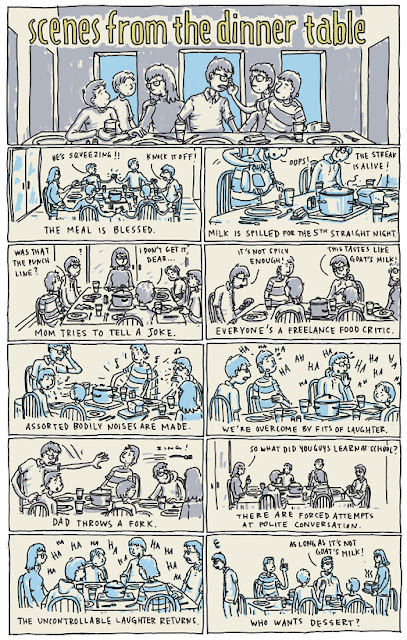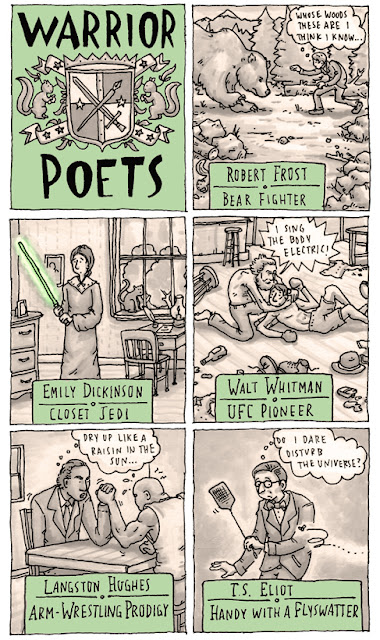Grant Sinder began his career as a comic artist by drawing a weekly comic strip for the Kansas City Star called Delayed Karma. A dental student turned obsessed comic, Snider demonstrates great talent in a variety of contexts within the comic strip domain - on top of that, his work is brilliantly funny.
Surgeons who played video games improved their eye-hand coordination, committed 37% fewer mistakes in laparoscopic surgery, and increased their task rate by 27% as compared to their counterparts who did not play video games. Snider, who is currently studying orthodontics at the University of Colorado-Denver, may someday be another example of the cross-creative process employed by the surgeons in this study.
HOW IT WORKS
Creative processes are intuitive, applying them to non-related domains helps us apply this way of thinking to generate exceptional (and more creative) solutions to seemingly different problems. When we get wrapped up in the context of things, it takes creativity to keep searching for the content.
Drawing comics, playing video games, or gardening are all creative processes. Employing our creative side results in a myriad of skills and abilities that allow us to look for solutions that aren't as obvious to others. When we are creative, we are more inclined to throw out old strategies and purse new directions, we can appreciate and be comfortable with complexity and ambiguity, and eventually, we adopt a general attitude that includes refusing to prematurely pass judgment on ideas.
Irregardless of where creativity is applied, it goes without saying that people who actively pursue creative ventures reap the benefits of this process in unrelated areas. Like the Sinder and the surgeons in the study (hyperlinked) above, I believe we'd see many improvements in society and industry if allowed ourselves (and our nation's youth) to engage in tasks "just because" we find them personally enjoyable and beneficial.
This intrinsic motivation comes from within; it's clearly linked with our own identity, personality and interests. In this state, we don't care what others think. We're doing something just because we want to do it, and that's reason enough.
I can't say we'd see the same success if the surgeons were "only" playing video games to improve their surgery skills - unless something "kicked in" while they were playing a game and all of a sudden you hear your dad shout "Yes!" from the other room because he leveled up !!!
When we engage in a task just because we think we will derive an external benefit, we're less connected to who we are and more focused on the benefit that compelled us to do something we didn't really want to do in the first place (for a paycheck, award, grade, or someone else's approval).
Naturally, we're motivated by both intrinsic and extrinsic forces to think creatively. The key is keeping our motivations properly balanced.
If you're a student, checking out this post because you dig Incidental Comics, then email this post to your parents to justify an extra hour of video game playing, Manga reading, dancing, or skateboarding. Tell them that you are focused on a task that allows you to maintain your motivation in other key areas of your life (like school). If you need to hang out with your friends, remind them that the creative process isn't just a solitary activity. The usefulness of an idea is part of what makes it creative, and the people around us help make that evaluation. Even though the creative process is richly experienced on a personal level, creativity is also a decidedly social phenomenon.
If you're an adult reading this post, please forward this to all the generations of people in your life. Creativity is not limited to teenagers with braces. Creative people are often times pioneers in their careers, people who are later referred to as "ahead of their time," and people who clearly note the importance of the creative process in performing their careers, which they often times refer to as "getting the zone."
However creativity operates, the processes employed engage the cognitive (thinking) dimension. Cognition is more than facts and figures, it includes all the mental actions or processes of acquiring knowledge and understanding through thought, experience, and the senses. The result of this perception or creative eye is what we should focus on - the content, not the context (comics, video games, gardening, and so on).
INSTRUCTIONS:
1. Read Snider's comics.
2. Laugh when appropriate.
3. Go do something "just because"
4. Measure your increased performance at work or school.
5. Return to this email, and forward it to all your friends
(so they, too, can reap the benefits of intrinsic motivation)























































































